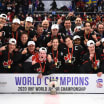VANCOUVER --Although they will need time to process the changes, NHL coaches appear to be overwhelmingly in favor of the enhancements to the video review system and expansion of the coach's challenge rule that the League announced Thursday.
NHL coaches in favor of rule changes for next season
Say it allows them to 'put the game in our hands more'

© Bruce Kluckhohn/Getty Images
The changes will go into effect starting next season.
"Everybody wants the game to end fairly and the right way within the rules," San Jose Sharks coach Peter DeBoer said following the annual Coaches Association meeting Friday. "It's a learning process, but we're taking steps toward making sure the result is right every night, or as close to right as we can get it, but we're not slowing the game down. That's the main thing."
RELATED: [NHL announces rule changes for video review, coach's challenge]
The coaches say they like that they will be able to challenge a goal scored off of a missed stoppage of play in the offensive zone, including plays that may involve pucks that hit off the protective spectator netting, a puck that is illegally high-sticked to a teammate in the offensive zone, a puck that has gone out of play but is subsequently touched in the offensive zone, and hand passes.
Coaches were already permitted to challenge for goalie interference and offside, after a goal was scored.
"This just gives us another opportunity to put ourselves in position to put the game in our hands more as a coach," New York Rangers coach David Quinn said. "It's huge. I mean, how many one-goal games are there in this league? You're talking about livelihoods here."
The added punitive measure of making a failed challenge result in a two-minute minor for delay of game and all subsequent failed challenges in the same game result in a double-minor has coaches thinking about how often they're going to use a challenge.
There previously had been a minor penalty associated with a failed offside challenge, but going forward it will be equal across the board in all three challenge categories.
"The consequence has gone up if you're challenging and you're not right," New Jersey Devils coach John Hynes said. "Although the rule is it has to be clear-cut, sometimes the definition of clear-cut are also different. But it's something that you have to find a way to be good at it and make the right decisions any time you have to challenge something with a consequence."
It will be an increasingly difficult decision considering that power-play percentages have risen recently. The NHL average has been above 19 percent in each of the past three seasons after 22 straight seasons of it being 18 percent or lower.
"There's no question that will create less challenges," Detroit Red Wings coach Jeff Blashill said. "The definition of 100 percent right is probably different between every coach, but our job as coaches now is to learn what the standard of 100 percent right is. I just think you're going to end up with less challenges."
The new rules likely will lead to fewer challenges for goalie interference. Because there previously was no punitive measure for a failed goalie interference challenge, coaches would use it as a tactic to get their players a rest, essentially as a timeout, even when they thought it was a 50-50 play. That's not likely to happen as often anymore.
"It better be 75-25 now, I think," Minnesota Wild coach Bruce Boudreau said. "You better have more than a one-goal lead if you're calling it and you want it called back. If it's 2-1, for example, and you think they interfered with your goalie, you better be right, especially if you've missed one earlier in the game. The double minor would really hurt."
Coaches also appear in favor of the NHL giving referees the chance to review their own calls.
The referees will be required to go to video review when they call a non-fighting major or a match penalty, and they will have the discretion to go to video review on a high-sticking double minor if they're unsure whose stick caused the infraction.
Referees will be able to reverse a major penalty into a minor penalty, but they will not have the ability to rescind the penalty altogether. They will have the ability to nullify the high-sticking double minor if review shows it wasn't the penalized player's stick that caused the infraction.
All reviews will be done at the scorer's table and can be done in consultation with the other on-ice officials, but the referee will not be able to consult with the NHL Situation Room in Toronto.
"I like the fact that it's not reversed where you can take a two-minute penalty and make it a five-minute major," Blashill said. "There are very few five-minute majors called in the NHL, so if there is one that is wrong, boy, I think everybody involved would like to make it right."

















